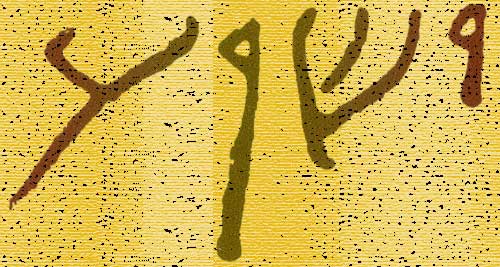7. In
Job 1:6-11; 2:1-6,
Satan appears among the sons of God, presenting himself before God in
heaven, as the accuser of the saints: again in
Zec 3:1, 2.
But at Christ's coming as our Redeemer, he fell from heaven,
especially when Christ suffered, rose again, and ascended to heaven.
When Christ appeared before God as our Advocate, Satan, the accusing
adversary, could no longer appear before God against us, but was
cast out judicially
(Ro 8:33, 34).
He and his angels henceforth range through the air and the earth, after
a time (namely, the interval between the ascension and the second
advent) about to be cast hence also, and bound in hell. That "heaven"
here does not mean merely the air, but the abode of angels, appears
from
Re 12:9, 10, 12;
1Ki 22:19-22.
there was--Greek, "there came to pass," or "arose."
war in heaven--What a seeming contradiction in terms, yet true!
Contrast the blessed result of Christ's triumph,
Lu 19:38,
"peace in heaven."
Col 1:20,
"made peace through the blood of His cross, by Him to reconcile
all things unto Himself; whether . . . things in earth, or
things in heaven."
Michael and his angels . . . the dragon . . .
and his angels--It was fittingly ordered that, as the rebellion
arose from unfaithful angels and their leader, so they should be
encountered and overcome by faithful angels and their archangel, in
heaven. On earth they are fittingly encountered, and shall be overcome,
as represented by the beast and false prophet, by the Son of man and
His armies of human saints
(Re 19:14-21).
The conflict on earth, as in
Da 10:13,
has its correspondent conflict of angels in heaven. Michael is
peculiarly the prince, or presiding angel, of the Jewish nation. The
conflict in heaven, though judicially decided already against Satan
from the time of Christ's resurrection and ascension, receives its
actual completion in the execution of judgment by the angels who cast
out Satan from heaven. From Christ's ascension he has no
standing-ground judicially against the believing elect.
Lu 10:18,
"I beheld (in the earnest of the future full fulfilment given in the
subjection of the demons to the disciples) Satan as lightning fall from
heaven." As Michael fought before with Satan about the body of the
mediator of the old covenant
(Jude 9),
so now the mediator of the new covenant, by offering His sinless body
in sacrifice, arms Michael with power to renew and finish the conflict
by a complete victory. That Satan is not yet actually and
finally cast out of heaven, though the judicial sentence
to that effect received its ratification at Christ's ascension, appears
from
Eph 6:12,
"spiritual wickedness in high (Greek, 'heavenly')
places." This is the primary Church-historical sense here. But, through
Israel's unbelief, Satan has had ground against that, the elect nation,
appearing before God as its accuser. At the eve of its restoration, in
the ulterior sense, his standing-ground in heaven against Israel, too,
shall be taken from him, "the Lord that hath chosen Jerusalem"
rebuking him, and casting him out from heaven actually and for
ever by Michael, the prince, or presiding angel of the Jews. Thus
Zec 3:1-9
is strictly parallel, Joshua, the high priest, being representative of
his nation Israel, and Satan standing at God's fight hand as adversary
to resist Israel's justification. Then, and not till then, fully
(Re 12:10,
"NOW," &c.) shall ALL
things be reconciled unto Christ IN HEAVEN
(Col 1:20),
and there shall be peace in heaven
(Lu 19:38).
against--A, B, and C read, "with."
JFB.
The Book of Revelation
Revelation 1:9-11 - I John, who also am your brother, and companion in tribulation, and in the kingdom and patience of Jesus Christ, was in the isle that is called Patmos, for the word of God, and for the testimony of Jesus Christ. I was in the Spirit on the Lord's day, and heard behind me a great voice, as of a trumpet, Saying, I am Alpha and Omega, the first and the last: and, What thou seest, write in a book, and send [it] unto the seven churches which are in Asia; unto Ephesus, and unto Smyrna, and unto Pergamos, and unto Thyatira, and unto Sardis, and unto Philadelphia, and unto Laodicea.
Revelation 19:11-16 - And I saw heaven opened, and behold a white horse; and he that sat upon him [was] called Faithful and True, and in righteousness he doth judge and make war. His eyes [were] as a flame of fire, and on his head [were] many crowns; and he had a name written, that no man knew, but he himself. And he [was] clothed with a vesture dipped in blood: and his name is called The Word of God. And the armies [which were] in heaven followed him upon white horses, clothed in fine linen, white and clean. And out of his mouth goeth a sharp sword, that with it he should smite the nations: and he shall rule them with a rod of iron: and he treadeth the winepress of the fierceness and wrath of Almighty God. And he hath on [his] vesture and on his thigh a name written, KING OF KINGS, AND LORD OF LORDS.
Revelation 22:18-20 For I testify unto every man that heareth the words of the prophecy of this book, If any man shall add unto these things, God shall add unto him the plagues that are written in this book: And if any man shall take away from the words of the book of this prophecy, God shall take away his part out of the book of life, and out of the holy city, and [from] the things which are written in this book. He which testifieth these things saith, Surely I come quickly. Amen. Even so, come, Lord Jesus.
Revelation in The New Testament - A Brief Overview

Painting of St. John the Evangelist by Reni - 1620
Introduction to The Book of Revelation
Brief Summary. John describes the seven churches in Asia, he records the visions that he received, and in the prophecy Jesus returns as the kinsman redeemer to claim this world as His inheritance. The final battle unfolds in a 7 year period through a series of seal, trumpet, and bowl judgements, He casts the antichrist and false prophet into the lake of fire and sets up the New Jerusalem, the new heaven and new earth for the redeemed. The book of Revelation is in harmony with the prophecies in the Old Testament especially the ones written by Ezekiel, Daniel and Zechariah.
Summary of The Book of Revelation
Author. John the apostle names himself as the one who wrote down what the Lord said through the angel. The earliest writers in the church like Justin Martyr, Irenaeus, Hippolytus, Tertullian, Clement of Alexandria and the Muritorian all credit John the apostle as author of the book of Revelation.
Date. John indicates that he was on the Island of Patmos when he received the prophecy (Revelation 1:9). According to tradition John wrote during the reign of the Emperor Domitian which would have been around 95 AD. Tradition also states that John was released the next year and was allowed to return to Ephesus. Domitian was perhaps the cruelest Emperor toward the Christians, demanding that he was to worshipped as deity, or be put to death.
Audience. John said that the prophecy was directed to the seven churches in Asia (Revelation 1:4).
Outline of the Book of Revelation
Description and Fate of False Teachers - 1:1-16
Encouragement to Believers in Christ - 1:17-25

The Name Jesus In Ancient Hebrew Text
"Yeshua" in First Century Hebrew Text. This is how the name "Jesus"
would have been written in ancient Hebrew documents. The four letters or
consonants from right to left are Yod, Shin, Vav, Ayin (Y, SH, OO, A).
Jesus is the Greek name for the Hebrew name Joshua or Y'shua which means
"The LORD or Yahweh is Salvation".
The Book of Revelation Resources
Map of the Roman Empire (14 A.D.) - This map reveals the Roman Empire during the time shortly after the birth of Jesus, in 14 AD at the time of the death of Augustus. The order which prevailed in this extensive empire, the good military roads, and the use of Koine Greek as the general language of culture throughout the area were among the factors which multiplied the rapid spread of the Gospel of Jesus Christ. (Color Map)
Map of Paul's First Missionary Journey (48 A.D.) - This map reveals the areas in Asia Minor where Paul visited in his first missionary journey. Around 48 AD, in the springtime, Paul and his companions Barnabas and Mark were sent on a mission from the church in Antioch. This would be the first of Paul's Missionary Journey's. (Color Map)
Map of Paul's Second Missionary Journey (51 A.D.) - This map reveals the areas in Asia and Greece where Paul visited in his second missionary journey. Paul re-visits a couple cities in Asia, one of which was Lystra where he was stoned and left for dead a few years earlier. He later has a vision that leads him over to Greece and Paul and his companions travel and minister in various cities in Greece (Philippi, Thessalonica, Berea, Athens and Corinth. Later Paul returns to Ephesus and finally to Caesarea and Antioch. (Color Map)
Map of Paul's Third Missionary Journey (54 A.D.) - This map reveals the areas in Asia and Greece where Paul visited in his third missionary journey. On Paul's third missionary journey he returned to the cities he had first visited on his first missionary journey. During this time he decided to remain in Ephesus for about 3 years, and this city was the main focus of his activities and an important Christian community (Acts 19). (Color Map)
Map of the New Testament World - This map reveals the "Nations" within the ancient world during the first century A.D., the time of the New Testament. The map includes the areas of Israel, Asia, Greece, and Italy. (Color Map)
Map of New Testament Greece This map reveals the cities within Greece in the ancient world during the first century A.D.,The map includes the principal cities of Greece like: Athens, Corinth, and Thessalonica, and provinces like Macedonia and Achaia. (Color Map)
Map of New Testament Asia - This map shows the cities within
Asia Minor during the first century A.D., the time of the New
Testament. The map includes the principal cities of Asia
including Tarsus, Ephesus, and Colossae, and provinces like
Galatia and Pamphilia. (Color Map)